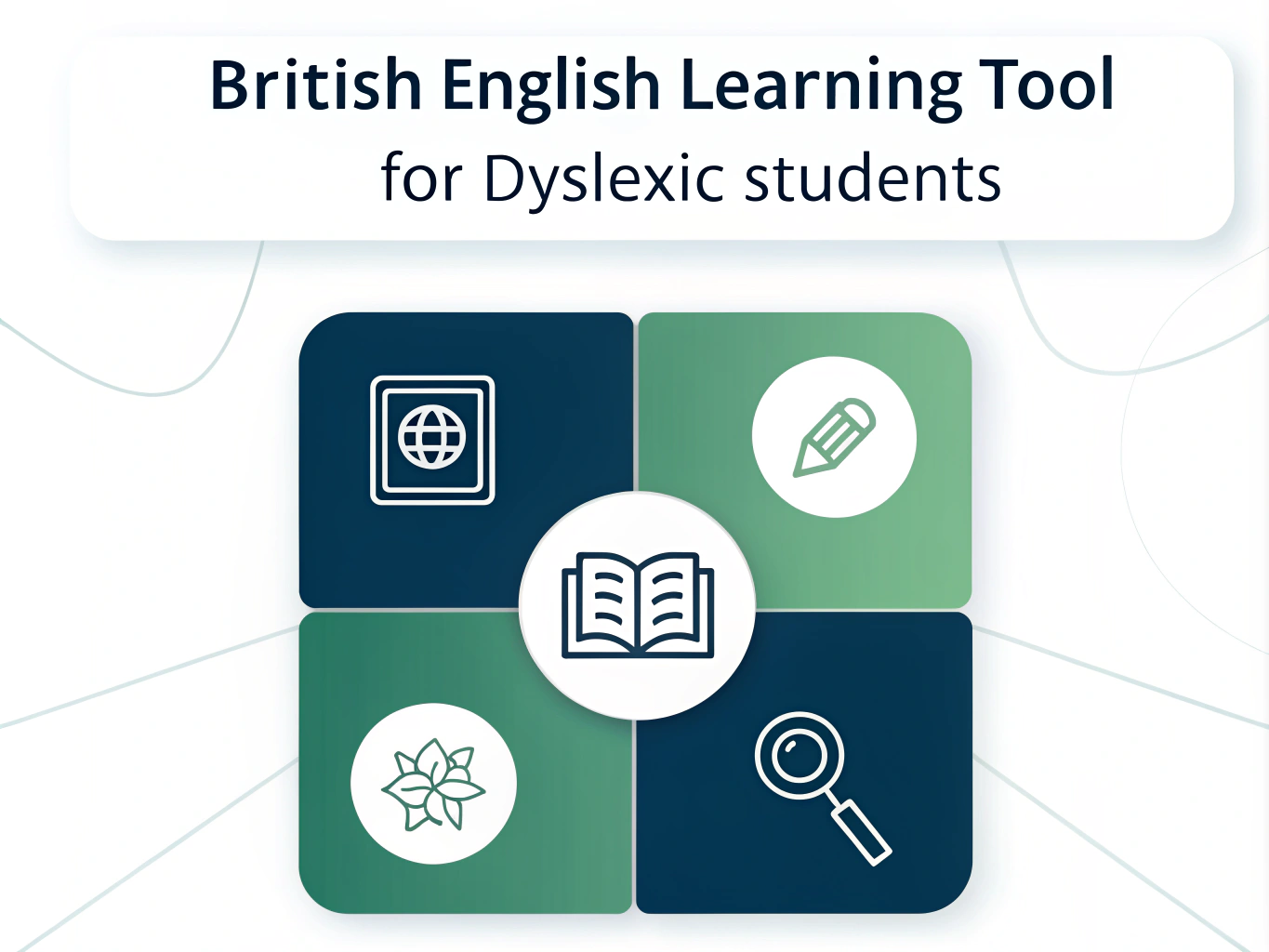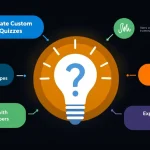British English Learning for Dyslexic Students
Is this tool helpful?
How to Use the British English Spelling & Grammar Tool Effectively
This tool helps you create a personalised learning plan tailored to your British English spelling and grammar needs as a dyslexic learner. To get the most from it, follow these simple steps:
- Enter your age: Provide your current age in the “Age of the student” field. For example, you might enter 12 if you’re a middle schooler or 28 if you’re an adult learner improving your skills.
- Select your English proficiency level: Choose your current level from the dropdown menu. Examples include Beginner if you’re new to English or Intermediate if you understand basics but need to refine grammar.
- Describe your specific challenges (optional): Use this field to explain any difficulties you face relating to dyslexia or English learning. For instance, confusing homophones or problems with verb tenses.
- Submit your details: Click the “Get Personalized Learning Plan” button to receive a customised strategy designed to improve your spelling and grammar skills efficiently.
After submitting, the tool will analyse your inputs and produce a tailored learning plan that appears below the form. This plan includes exercises, strategies, and resources specifically suited to your age, level, and challenges.
What This British English Spelling and Grammar Tool Offers You
This tool supports dyslexic students and learners by providing targeted, user-friendly strategies to improve British English spelling and grammar. It adjusts learning plans based on your age, current proficiency, and individual difficulties.
Its key benefits include:
- Custom learning plans: Receive advice tailored precisely to your age and English level.
- Dyslexia-aware methods: Access techniques designed to address dyslexia-related challenges, such as memory aids and phonetic strategies.
- Focus on British English: Learn the spelling, grammar, and vocabulary unique to British English, avoiding American English confusion.
- Comprehensive coverage: Improve spelling rules, understand grammar clearly, and practice with relevant exercises.
- Recommended resources: Discover apps, tools, and materials ideal for boosting your British English skills effectively.
Practical Uses of This Tool for Dyslexic Learners
While the tool does not perform instant calculations, it generates personalised learning plans that you can use to improve throughout your study or daily English use. Here are some practical applications of the tailored strategies it provides:
1. Improving Spelling Skills
The tool offers approaches to simplify complex British English spelling for dyslexic learners:
- Phonetic breakdowns: Learn to split words into sounds for easier memorisation.
- Memory aids: Apply mnemonics to remember tricky spellings, such as silent letters.
- Visual strategies: Use colour-coding and imagery to reinforce word patterns.
2. Clarifying Grammar Rules
Grammar can be challenging, so the tool provides simplified explanations and ways to practice British English grammar:
- Concise rule summaries: Break grammar concepts into digestible parts.
- Visual aids: Use charts and diagrams to understand sentence structures.
- Practical exercises: Apply grammar rules in writing and speaking scenarios.
3. Understanding British vs. American English
This tool guides you on distinctive British English conventions to avoid confusion:
- Spelling variations: Grasp differences such as “theatre” vs. “theater” and “defence” vs. “defense”.
- Unique vocabulary: Learn Britain-specific words and phrases.
- Punctuation differences: Understand subtle variations in British punctuation use.
Example: A Custom Learning Plan
Imagine a 14-year-old learner with beginner English proficiency who struggles with punctuation and mixing up homophones. Their plan might include:
- Punctuation practice: Exercises focusing on commas and apostrophes in British English context.
- Homophone drills: Visual flashcards differentiating words like “bare” and “bear”.
- British English spelling rules: Lessons on common endings such as “-ise” instead of “-ize”.
- Grammar basics: Practice forming questions and negatives in the present simple tense.
- Recommended resource: Using an app that integrates multisensory spelling methods tailored for dyslexic learners.
Real-Life Applications to Strengthen Your British English
Here are ways you can apply this personalised learning plan in everyday situations to enhance your English skills:
Academic Writing
- Proper punctuation: Use the correct British English punctuation in essays and assignments.
- Formal style: Avoid slang and use formal expressions common in British academic writing.
- Citing sources: Understand British referencing styles versus American formats.
Example: Writing a research paper with correctly placed commas and British spellings like “organisation” instead of “organization”.
Professional Communication
- Email etiquette: Write clear, polite emails with appropriate British formalities.
- CV writing: Tailor your CV and cover letter to British English standards and terminology.
- Presentations: Improve how you convey ideas with correct grammar and pronunciation.
Example: Preparing a cover letter using professional phrases like “I look forward to hearing from you” and using British spellings.
Social Media and Digital Communication
- Hashtag usage: Create hashtags with British spellings and conventions.
- Concise posts: Craft short messages that follow grammar rules without errors.
- Internet slang: Recognise common British online expressions suitable for digital platforms.
Example: Writing accurate tweets about current news with British spelling of words like “favour” and “organisation”.
Creative and Literature Writing
- Poetry techniques: Practice alliteration and rhyme schemes popular in British poetry.
- Authentic dialogue: Write realistic conversations using British accents and colloquialisms.
- Descriptive writing: Enhance imagery and vocabulary for vivid descriptions.
Example: Crafting a short story set in London using idiomatic British English expressions.
Travel and Cultural Exchange
- Accent awareness: Learn differences between regional British accents.
- Cultural idioms: Use common British phrases and references accurately.
- Daily vocabulary: Master essential terms for transport, dining, and shopping in the UK.
Example: Preparing for a trip to Manchester by practising local expressions and travel-related vocabulary.
Frequently Asked Questions About the British English Dyslexia Tool
1. How is this tool different from general English learning resources?
This tool specialises in British English and helps dyslexic learners through strategies tailored specifically to their needs. Unlike generic resources, it focuses on dyslexia-friendly methods that harness strengths like visual memory and creativity.
2. Does it help with pronunciation as well as spelling and grammar?
While primarily focused on spelling and grammar, the tool includes pronunciation tips where relevant, especially for silent letters and tricky sounds common in British English.
3. Can learners of any age benefit from this tool?
Yes. By entering your age and proficiency, the tool adjusts its recommendations to suit your learning stage, whether you’re a child or an adult.
4. How often should I use the tool for best results?
Use the tool every 4-6 weeks to generate updated learning plans. Regular practice of the provided strategies and exercises (about 15-20 minutes daily) will help you improve steadily.
5. Can the tool cater to exam preparation?
Yes. When you specify your learning goals, such as preparing for GCSE or IELTS, the tool customises strategies to meet those exam requirements while supporting your dyslexia.
6. Does it address the emotional challenges of learning with dyslexia?
The tool recognises emotional aspects and provides encouragement along with practical strategies to build confidence and motivation throughout your British English learning journey.
Important Disclaimer
The calculations, results, and content provided by our tools are not guaranteed to be accurate, complete, or reliable. Users are responsible for verifying and interpreting the results. Our content and tools may contain errors, biases, or inconsistencies. Do not enter personal data, sensitive information, or personally identifiable information in our web forms or tools. Such data entry violates our terms of service and may result in unauthorized disclosure to third parties. We reserve the right to save inputs and outputs from our tools for the purposes of error debugging, bias identification, and performance improvement. External companies providing AI models used in our tools may also save and process data in accordance with their own policies. By using our tools, you consent to this data collection and processing. We reserve the right to limit the usage of our tools based on current usability factors.







